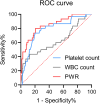Clinical significance of platelet-to-white blood cell ratio in patients with Wilson disease: a retrospective cohort study
- PMID: 40321812
- PMCID: PMC12047222
- DOI: 10.7717/peerj.19379
Clinical significance of platelet-to-white blood cell ratio in patients with Wilson disease: a retrospective cohort study
Abstract
Objective: To assess the correlation between the platelet-to-white blood cell ratio (PWR) and the severity of liver dysfunction, hepatic complications, and prognosis in Wilson disease (WD) patients.
Methods: A retrospective analysis was conducted on medical records from January 1, 2016, to March 30, 2022. Both univariate and multivariate analyses were performed to examine the impact of a low PWR (<26.3) on WD severity, liver complications, and disease progression. Additionally, the effect of splenectomy on PWR was evaluated.
Results: The study included 315 patients with WD, among whom 105 had a low PWR and 210 had a high PWR. Those with low PWR exhibited significantly elevated levels of bilirubin, international normalized ratio, prothrombin time, procollagen type-III N-terminal propeptide, type IV collagen, hyaluronic acid, and portal vein diameter. Conversely, they had lower levels of albumin, total cholesterol, low-density lipoprotein cholesterol, and triglycerides (all P < 0.05). A low PWR correlated with a greater incidence of splenomegaly/hypersplenism, esophagogastric varices, and ascites (all P < 0.05). Furthermore, low PWR independently predicted hepatic decompensation (P < 0.05), and splenectomy led to a marked increase in PWR among WD patients (P < 0.001).
Conclusion: A low PWR in WD patients is linked to heightened disease severity, increased risk of liver complications, and rapid progression to decompensation. The results imply that splenectomy, by enhancing PWR, may serve as a viable strategy to slow WD progression.
Keywords: Blood platelets; Hepatolenticular degeneration; Leukocytes; Liver cirrhosis; Splenectomy.
© 2025 Zhong et al.
Conflict of interest statement
The authors declare that they have no competing interests.
Figures


Similar articles
-
Differential hepatic features presenting in Wilson disease-associated cirrhosis and hepatitis B-associated cirrhosis.World J Gastroenterol. 2019 Jan 21;25(3):378-387. doi: 10.3748/wjg.v25.i3.378. World J Gastroenterol. 2019. PMID: 30686905 Free PMC article.
-
Nomogram for prediction of portal vein system thrombosis after splenectomy for hypersplenism in patients with Wilson disease.Ann Palliat Med. 2022 Dec;11(12):3626-3635. doi: 10.21037/apm-22-826. Epub 2022 Dec 12. Ann Palliat Med. 2022. PMID: 36571168
-
Anemia Is Associated with Disease Severity, Hepatic Complications, and Progression of Wilson Disease: A Retrospective Cohort Study.Dig Dis. 2023;41(4):632-640. doi: 10.1159/000530473. Epub 2023 Apr 5. Dig Dis. 2023. PMID: 37019089
-
Cirrhosis in Wilson Disease is characterized by Impaired Hepatic Synthesis, Leukopenia and Thrombocytopenia.Int J Med Sci. 2020 May 29;17(10):1345-1350. doi: 10.7150/ijms.44338. eCollection 2020. Int J Med Sci. 2020. PMID: 32624691 Free PMC article.
-
Hepatic features of Wilson disease.Handb Clin Neurol. 2017;142:91-99. doi: 10.1016/B978-0-444-63625-6.00009-4. Handb Clin Neurol. 2017. PMID: 28433114 Review.
References
-
- Adamstein NH, Cornel JH, Davidson M, Libby P, de Remigis A, Jensen C, Ekstrom K, Ridker PM. Association of interleukin 6 inhibition with ziltivekimab and the neutrophil-lymphocyte ratio: a secondary analysis of the RESCUE clinical trial. JAMA Cardiology. 2023;8(2):177–181. doi: 10.1001/jamacardio.2022.4277. - DOI - PMC - PubMed
-
- Adamstein NH, MacFadyen JG, Rose LM, Glynn RJ, Dey AK, Libby P, Tabas IA, Mehta NN, Ridker PM. The neutrophil-lymphocyte ratio and incident atherosclerotic events: analyses from five contemporary randomized trials. European Heart Journal. 2021;42(9):896–903. doi: 10.1093/eurheartj/ehaa1034. - DOI - PMC - PubMed
-
- Coffey AJ, Durkie M, Hague S, McLay K, Emmerson J, Lo C, Klaffke S, Joyce CJ, Dhawan A, Hadzic N, Mieli-Vergani G, Kirk R, Elizabeth Allen K, Nicholl D, Wong S, Griffiths W, Smithson S, Giffin N, Taha A, Connolly S, Gillett GT, Tanner S, Bonham J, Sharrack B, Palotie A, Rattray M, Dalton A, Bandmann O. A genetic study of Wilson’s disease in the United Kingdom. Brain. 2013;136(5):1476–1487. doi: 10.1093/brain/awt035. - DOI - PMC - PubMed
-
- Colapietro F, Maisonneuve P, Lytvyak E, Beuers U, Verdonk RC, van der Meer AJ, van Hoek B, Kuiken SD, Brouwer JT, Muratori P, Aghemo A, Carella F, van den Berg AP, Zachou K, Dalekos GN, Di Zeo-Sanchez DE, Robles M, Andrade RJ, Montano-Loza AJ, van den Brand FF, Slooter CD, Macedo G, Liberal R, de Boer YS, Lleo A, Dutch AIH Study Group. International Autoimmune Hepatitis Group Incidence and predictors of hepatocellular carcinoma in patients with autoimmune hepatitis. Journal of Hepatology. 2024;80(1):53–61. doi: 10.1016/j.jhep.2023.09.010. - DOI - PubMed
MeSH terms
LinkOut - more resources
Full Text Sources
Medical

